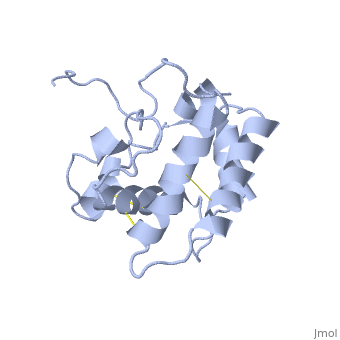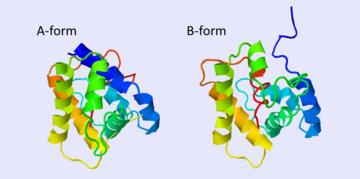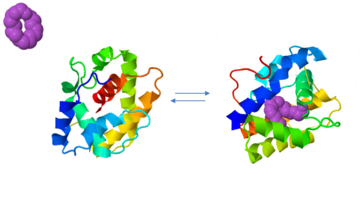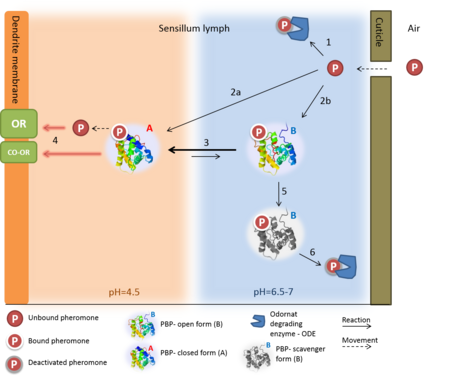Odorant binding protein
From Proteopedia
| Line 63: | Line 63: | ||
This model is supported by the pH dependent conformation transition, that is described above. The bulk of the sensillar lymph is in neutral pH (6.5-7), while environment near the dendrite membrane bears a low pH (4.5), due to the negative charges on the surface of the membrane <ref>DOI: 10.1016/0040-8166(84)90004-1</ref>, which cause the accumulation of positively charged kations near the membrane surface (20-50 nm)<ref name="kaissling" /><ref>. According to this model, the pheromone is entering the sensillar lymph through a pore in the cuticle, then it can be either degraded by odorant degrading enzymes (ODE) or bind to a PBP (of both forms). Once the complex is arriving to the low pH environment near the dendrite membrane the PBP will shift to the A-form, thereby ejaculating the ligand from the binding pocket, allowing it to activate the OR:CO-OR complex and the cellular signal transduction begins. | This model is supported by the pH dependent conformation transition, that is described above. The bulk of the sensillar lymph is in neutral pH (6.5-7), while environment near the dendrite membrane bears a low pH (4.5), due to the negative charges on the surface of the membrane <ref>DOI: 10.1016/0040-8166(84)90004-1</ref>, which cause the accumulation of positively charged kations near the membrane surface (20-50 nm)<ref name="kaissling" /><ref>. According to this model, the pheromone is entering the sensillar lymph through a pore in the cuticle, then it can be either degraded by odorant degrading enzymes (ODE) or bind to a PBP (of both forms). Once the complex is arriving to the low pH environment near the dendrite membrane the PBP will shift to the A-form, thereby ejaculating the ligand from the binding pocket, allowing it to activate the OR:CO-OR complex and the cellular signal transduction begins. | ||
| - | |||
*'''Activation by the complex pheromone-PBP''' | *'''Activation by the complex pheromone-PBP''' | ||
An alternative mode of action was proposed for the receptor activation in ''Drosophila melanogaster'', where it was found that the complex of pheromone-PBP is required for the activity of pheromone-sensitive neurons <ref>DOI: 10.1016/j.neuron.2004.12.031<ref/><ref>doi: 10.1016/j.cell.2008.04.046<ref/> | An alternative mode of action was proposed for the receptor activation in ''Drosophila melanogaster'', where it was found that the complex of pheromone-PBP is required for the activity of pheromone-sensitive neurons <ref>DOI: 10.1016/j.neuron.2004.12.031<ref/><ref>doi: 10.1016/j.cell.2008.04.046<ref/> | ||
Revision as of 12:16, 28 January 2015
Contents |
Introduction
Odorant-binding protein (OBP) are soluble proteins which involve in the processes of odorant detection in the olfactory sensilla [1]
Though functionally same, vertebrates and insects OBP have different origin and structure. OBPs are important for insect olfaction. For instance, OBP76a (LUSH) in the fly Drosophila melanogaster is required for the detection of the pheromone vaccenyl acetate [2] and has been proven to adopt a conformation that activates the odorant receptor [3].
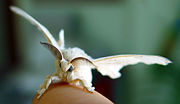
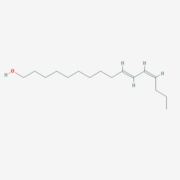
OBP in insects
OBP Function
Despite five decades of intensive research, the exact roles of OBP and the mechanism by which the odorant receptor (OR) is activated are still in dispute [4][5].
A few functions have been suggested for OBP:
1. Solubelizing the odorant molecule and its transportation in the sensillar lymph.
2. Protecting the odorant molecule from the odorant degrading enzymes, in the sensillar lymph.
3. Activating of the odorant receptor on the dendrite membrane, by the odorant-OBP complex.
4. Mediating the deactivation of the odorant molecule after the activation of the receptor.
5. An organic anion (the protein has 9 negative charges).
Of all, the first role of OBP as an odorant solubilizer and carrier is generally accepted.
In order to explain the structure and function of these fascinating proteins, this page will further focus on a particular OBP - the well investigated Bombyx mori PBP: BmorPBP.
Bombyx mori BmorPBP (lets talk about sex..)
| |||||||||||
See also
- Odorant_binding_protein_3D_structures
- Chemical communication in arthropods
- Pheromone binding protein
References
Proteopedia Page Contributors and Editors (what is this?)
Nurit Eliash, Michal Harel, Joel L. Sussman, Alexander Berchansky, Jaime Prilusky
